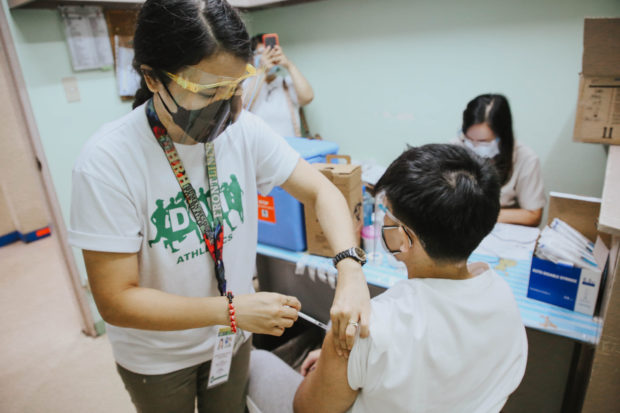
A minor gets his vaccine against COVID-19 during the launch of pediatric inoculation in Olongapo City. (Photo courtesy of Olongapo City Information Office)
MANILA, Philippines — Children ages 5 to 11 are still not eligible for COVID-19 booster shots despite the resumption of in-person classes this month, as there is still no scientific evidence to support the need for booster doses for that age group, according to the Department of Health (DOH).
“Until now, evidence is still incomplete, globally, regarding booster shots for 5 to 11 [years old]. For now, the [primary or] first two doses are still enough to protect them, especially against severe and critical infection,” Maria Rosario Vergeire, officer in charge of the DOH, said in a press briefing on Tuesday.
She emphasized that focus should still be on ramping up inoculation for the primary doses, as she cited the latest DOH data that only 4.2 million, or about 40 percent, of the 5-11 age group have been fully vaccinated against COVID-19.
“We’re still looking at 60 percent of this eligible age group who need to get vaccinated,” Vergeire said.
“Let’s try to encourage mothers and legal guardians to have their children inoculated so that they will be safe when they return to school,” she added.
Replacing expired vaccines
“If there is one or two COVID[-19] cases, the school doesn’t need to shut down. The classroom with the [confirmed] case would have to close down. The [exposed] children should be quarantined and should be monitored every day,” Vergeire also said, as she noted the start of the school year on Aug. 22.
She also disclosed that the World Health Organization (WHO)-led Covax Facility has pledged to replace expired vaccines in the country’s stockpile.
“We have already gotten the commitment of Covax that they will be replacing all of these expired doses, even from the private sector and local governments,” she said.
“[But] right now, we still have sufficient supply. We are negotiating that the arrival of these replacement doses [will] be set by the time we would need more vaccines already,” Vergeire added.
According to her, the country’s vaccine wastage is only at 6.6 percent, still below the acceptable standard of 10 percent set by WHO—although this was a slight increase from 4.7 percent in June.
Representatives of the private sector had said that some 4.25 million doses worth about P5 billion had expired because of a “lack of [sense] of urgency” from the DOH and the Health Technology Assessment Council to widen eligibility of second boosters to more segments of the population.
The department has since allowed adults with existing comorbidities and those in the 50-59 age group to receive second booster shots.
Meanwhile, only one COVID-19 vaccine manufacturer, Johnson & Johnson of the United States, has applied for a certificate of product registration before the Food and Drug Administration, in the event the state of calamity prevailing in the country because of the pandemic is lifted by September. The vaccines are currently approved only for emergency use.
Hospitalizations ‘manageable’
The country’s health-care system remained “manageable” in the past week despite a monthlong increase in COVID-19 hospitalizations, Vergeire said.
She said hospitals were mandated to impose what she called an “accordion” policy, under which public hospitals must expand their bed capacity up to 50 percent and private hospitals, up to 30 percent when admissions increase again.
An increase in intensive care unit admissions and hospitalization of severe and critical infections was sustained since early July, according to the latest DOH data.
In the past week, four regions—Calabarzon, Western Visayas, Zamboanga Peninsula and Davao—had a bed utilization rate of at least 44 percent, still below the moderate-risk threshold of 50 percent set by the department.
“Let me assure everybody: Even though hospitalizations in some areas are increasing, [the situation is] still manageable and we can still expand beds to ensure access to hospitals,” Vergeire said.
A daily average of nearly 4,000 infections were recorded in the recent week, 13 percent higher than the previous period.
But the country remained at low risk for COVID-19 transmission, with an average daily attack rate of 3.4 cases per 100,000 population.
There were 906 new cases of the Omicron subvariant BA.5, 11 more cases of BA.4, and seven additional cases of BA.2.12.1, according to genome sequencing results on Aug. 7 and Aug. 8.
RELATED STORIES
US CDC backs COVID boosters for children 5 to 11
Amid push for boosters, many in PH still fear ‘side effects’